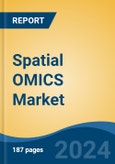Instruments is the fastest growing segment, North America is the largest market globally
Speak directly to the analyst to clarify any post sales queries you may have.
10% Free customizationThis report comes with 10% free customization, enabling you to add data that meets your specific business needs.
Key Market Drivers
The continuous evolution of spatial profiling platforms significantly propels the Global Spatial OMICS Market by enhancing resolution, throughput, and analytical depth in tissue analysis. Innovations like advanced imaging modalities, refined sequencing chemistries, and sophisticated computational tools now enable precise mapping of molecular interactions within complex cellular architectures. These technological strides provide an unprecedented ability to characterize cellular heterogeneity and tissue microenvironments, moving beyond bulk analysis to granular spatial insights.Key Market Challenges
The substantial cost associated with advanced instrumentation and specialized reagents presents a significant impediment to the broader adoption and growth of the Global Spatial OMICS Market. These high capital expenditures restrict access for numerous potential users, particularly smaller academic laboratories and emerging research entities operating with constrained budgets. Such financial barriers limit the acquisition of necessary equipment, thereby slowing the expansion of research capabilities and the pace of innovation within these critical segments.Key Market Trends
Advanced AI and Machine Learning Integration in Data Analysis represents a significant trend in the Global Spatial OMICS Market by enabling sophisticated interpretation of complex, high-dimensional datasets. The integration of these computational approaches moves beyond traditional statistical methods, allowing for enhanced pattern recognition, improved data accuracy, and streamlined analytical workflows crucial for deciphering intricate biological systems. For instance, according to Aignostics, in October 2025, the company launched Atlas H&E-TME, an AI-powered application designed for the robust analysis of the tumor microenvironment in H&E images at single-cell resolution, which integrates with spatial transcriptomics for refined cell niche analyses.Key Market Players Profiled:
- 10x Genomics
- Dovetail Genomics
- S2 Genomics, Inc.
- NanoString Technologies, Inc.
- Seven Bridges Genomics
- PerkinElmer, Inc.
- Danaher Corporation
- IonPath, Inc.
- Millennium Science Pty Ltd.
- Akoya Biosciences, Inc
Report Scope:
In this report, the Global Spatial OMICS Market has been segmented into the following categories:By Product:
- Consumables
- Software
- Instruments
By Workflow:
- Sample Preparation
- Instrumental Analysis
- Data Analysis
By End-use:
- Biopharmaceutical & Biotechnology Companies
- Research Institutes
- Others
By Technology:
- Spatial Transcriptomics
- Spatial Genomics
- Spatial Proteomics
By Region:
- North America
- Europe
- Asia Pacific
- South America
- Middle East & Africa
Competitive Landscape
Company Profiles: Detailed analysis of the major companies present in the Global Spatial OMICS Market.Available Customizations:
With the given market data, the publisher offers customizations according to a company's specific needs. The following customization options are available for the report:- Detailed analysis and profiling of additional market players (up to five).
This product will be delivered within 1-3 business days.
Table of Contents
Companies Mentioned
- 10x Genomics
- Dovetail Genomics
- S2 Genomics, Inc.
- NanoString Technologies, Inc.
- Seven Bridges Genomics
- PerkinElmer, Inc.
- Danaher Corporation
- IonPath, Inc.
- Millennium Science Pty Ltd.
- Akoya Biosciences, Inc
Table Information
| Report Attribute | Details |
|---|---|
| No. of Pages | 185 |
| Published | November 2025 |
| Forecast Period | 2024 - 2030 |
| Estimated Market Value ( USD | $ 298.81 Million |
| Forecasted Market Value ( USD | $ 463.22 Million |
| Compound Annual Growth Rate | 7.5% |
| Regions Covered | Global |
| No. of Companies Mentioned | 10 |









